Upwards movement to a target at 1,338 was expected for Monday. So far upwards movement has reached 1,337.79.
Summary: Expect this downwards swing to continue to support, which is at about 1,310 to 1,305. The target is at 1,312, which is now just above the support zone. Do not expect this downwards swing to move in a straight line, because that is not how price behaves within a consolidation.
Only the most experienced of traders should attempt to trade when price is clearly consolidating as it currently is for Gold and GDX. The rest should either hedge or wait for a breakout and trade the next trend. Always use stops and invest only 1-5% of equity on any one trade.
New updates to this analysis are in bold.
Grand SuperCycle analysis is here.
Last in-depth historic analysis with monthly and several weekly charts is here, video is here.
There are multiple wave counts at this time at the weekly and monthly chart levels. In order to make this analysis manageable and accessible only two will be published on a daily basis, one bullish and one bearish. This does not mean the other possibilities may not be correct, only that publication of them all each day is too much to digest. At this stage, they do not diverge from the two possibilities below.
BULLISH ELLIOTT WAVE COUNT
FIRST WEEKLY CHART
Cycle wave b may be a single zigzag. Zigzags subdivide 5-3-5. Primary wave C must subdivide as a five wave structure and may be either an impulse or an ending diagonal. Overlapping at this stage indicates an ending diagonal.
Within an ending diagonal, all sub-waves must subdivide as zigzags. Intermediate wave (4) must overlap into intermediate wave (1) price territory. This diagonal is expanding: intermediate wave (3) is longer than intermediate wave (1) and intermediate wave (4) is longer than intermediate wave (2). Intermediate wave (5) must be longer than intermediate wave (3), so it must end above 1,398.41 where it would reach equality in length with intermediate wave (3).
Within the final zigzag of intermediate wave (5), minor wave B may not move beyond the start of minor wave A below 1,236.54.
Within the diagonal of primary wave C, each sub-wave is extending in price and so may also do so in time. Within each zigzag, minor wave B may exhibit alternation in structure and may show an increased duration.
Within intermediate wave (1), minor wave B was a triangle lasting 11 days. Within intermediate wave (3), minor wave B was a regular flat lasting 60 days. Within intermediate wave (5), minor wave B may last as long as 40 to 60 days. So far it has lasted 52 days (refer to daily chart) and the structure is incomplete.
At this stage, minor wave B may now be a combination or triangle. These two ideas are separated out in daily and hourly charts below.
This first weekly chart sees the upwards wave labelled primary wave A as a five wave structure. It must be acknowledged that this upwards wave looks better as a three than it does as a five. The fifth weekly chart below will consider the possibility that it was a three.
FIRST DAILY CHART – COMBINATION
Minor wave B may be a double combination. Double combinations are very common structures. The first structure in the double may have been a regular flat correction labelled minute wave w.
The double is joined by a three in the opposite direction, a zigzag labelled minute wave x.
The second structure in the double may be a zigzag labelled minute wave y. It would most likely end about the same level as minute wave w, at about 1,303.08, so that the whole structure takes up time and moves price sideways. That is the purpose of double combinations. The target would see minute wave y end somewhat above minute wave w and give the combination a typical sideways look.
Minute wave y as a zigzag now looks like an obvious three wave structure at the daily chart level.
When minute wave y is a complete zigzag, then the probability of the combination being over would be very high. While double combinations are very common structures, triples are extremely rare.
While minute wave y may also be a flat correction, in my experience double flats are fairly rare.
Minute wave y may also be a triangle but the expected pathway at this stage would be the same as the triangle wave count below, so it will not be separated out. A triangle within a combination is also in my experience uncommon.
HOURLY CHART – COMBINATION
Both wave counts at the daily chart level still expect that a zigzag downwards is unfolding. Both see minuette wave (b) complete.
Minuette wave (c) must subdivide as a five wave structure. So far subminuette waves i and now ii may be complete. This wave count now expects to see a low degree third wave unfold over the next day or so.
Subminuette wave ii may not move beyond the start of subminuette wave i above 1,347.58.
A new low below 1,326.02 would invalidate the alternate hourly chart below and provide some confidence in this main hourly chart.
HOURLY CHART – COMBINATION – ALTERNATE
If the degree of labelling within minuette wave (b) on the first hourly chart is moved down one degree, that may have only been subminuette wave a of a larger correction for minuette wave (b).
If subminuette wave a subdivides as a double zigzag, then minuette wave (b) may be continuing sideways as a flat or triangle.
Subminuette wave b is a 0.94 correction of subminuette wave a, indicating a regular flat correction for minuette wave (b) may be unfolding. But minuette wave (b) could unfold as a regular contracting or barrier triangle, and those ideas will be charted if sideways movement over the next day or so shows them to be likely.
If minuette wave (b) is a regular flat correction, then subminuette wave c would be very likely to make at least a slight new high above the end of subminuette wave a at 1,347.58 to avoid a truncation. The most likely Fibonacci ratio for subminuette wave c would be equality in length with subminuette wave a.
Expect very strong resistance about the upper edge of the orange Elliott channel if this wave count is correct.
Subminuette wave c must subdivide as a five wave structure, and within it micro wave 4 may not move into micro wave 1 price territory below 1,326.02.
SECOND DAILY CHART – TRIANGLE
This alternate daily chart is identical to the first daily chart up to the high labelled minor wave A. Thereafter, it looks at a different structure for minor wave B.
Minor wave B may be an incomplete triangle, and within it minute wave a may have been a double zigzag. All remaining triangle sub-waves must be simple A-B-C structures, and three of the four remaining sub-waves must be simple zigzags. One remaining sub-wave may be a flat correction.
Minute wave b may be a complete single zigzag. Minute wave c downwards must now complete as a simple correction, very likely a zigzag. Minute wave c of the triangle may not move beyond the end of minute wave a below 1,303.08. This invalidation point is black and white for both a barrier or contracting triangle; there is no room for subjectivity.
This alternate wave count expects weeks of choppy overlapping movement in an ever decreasing range.
Triangles normally adhere very well to their trend lines. The triangle trend lines are commonly tested within the triangle sub-waves. Minuette wave (b) within minute wave b may have found support at the a-c trend line, and this indicates where minute wave c may end.
Minute wave d of a contracting triangle may not move beyond the end of minute wave b above 1,356.12. Minute wave d of a barrier triangle should end about the same level as minute wave b; the triangle will remain valid as long as the b-d trend line remains essentially flat. In practice, this means minute wave d can end slightly above 1,356.12. This invalidation point is not black and white; it involves an area of subjectivity.
Contracting triangles are the most common type. Barrier triangles are not common, but nor are they rare.
A separate hourly chart will not be published today for this wave count because it would now be exactly the same as the first wave count. Both wave counts expect a zigzag is unfolding lower.
BEARISH ELLIOTT WAVE COUNT
FIFTH WEEKLY CHART
There were five weekly charts published in the last historic analysis. This fifth weekly chart is the most immediately bearish wave count, so this is published as a bearish possibility.
This fifth weekly chart sees cycle wave b as a flat correction, and within it intermediate wave (B) may be a complete triple zigzag. This would indicate a regular flat as intermediate wave (B) is less than 1.05 the length of intermediate wave (A).
If cycle wave b is a flat correction, then within it primary wave B must retrace a minimum 0.9 length of primary wave A at 1,079.13 or below. The most common length of B waves within flats is from 1 to 1.38 times the length of the A wave. The target calculated would see primary wave B end within this range.
I have only seen two triple zigzags before during my 10 years of daily Elliott wave analysis. If this wave count turns out to be correct, this would be the third. The rarity of this structure is identified on the chart.
FIFTH DAILY CHART
Minor wave 1 may have been a relatively brief impulse over at the low of the 8th of February. Thereafter, minor wave 2 may be an incomplete double combination.
The first structure in the double may be a zigzag labelled minute wave w. The double may be joined by a three in the opposite direction, a zigzag labelled minute wave x. The second structure in the double may be an incomplete triangle labelled minute wave y. This structure may yet take some weeks to complete. In my experience a double combination with a triangle for minute wave y is not very common. This reduces the probability of this wave count, but it remains valid.
This wave count is a good solution for this bearish wave count. All subdivisions fit and there are no rare structures.
TECHNICAL ANALYSIS
WEEKLY CHART
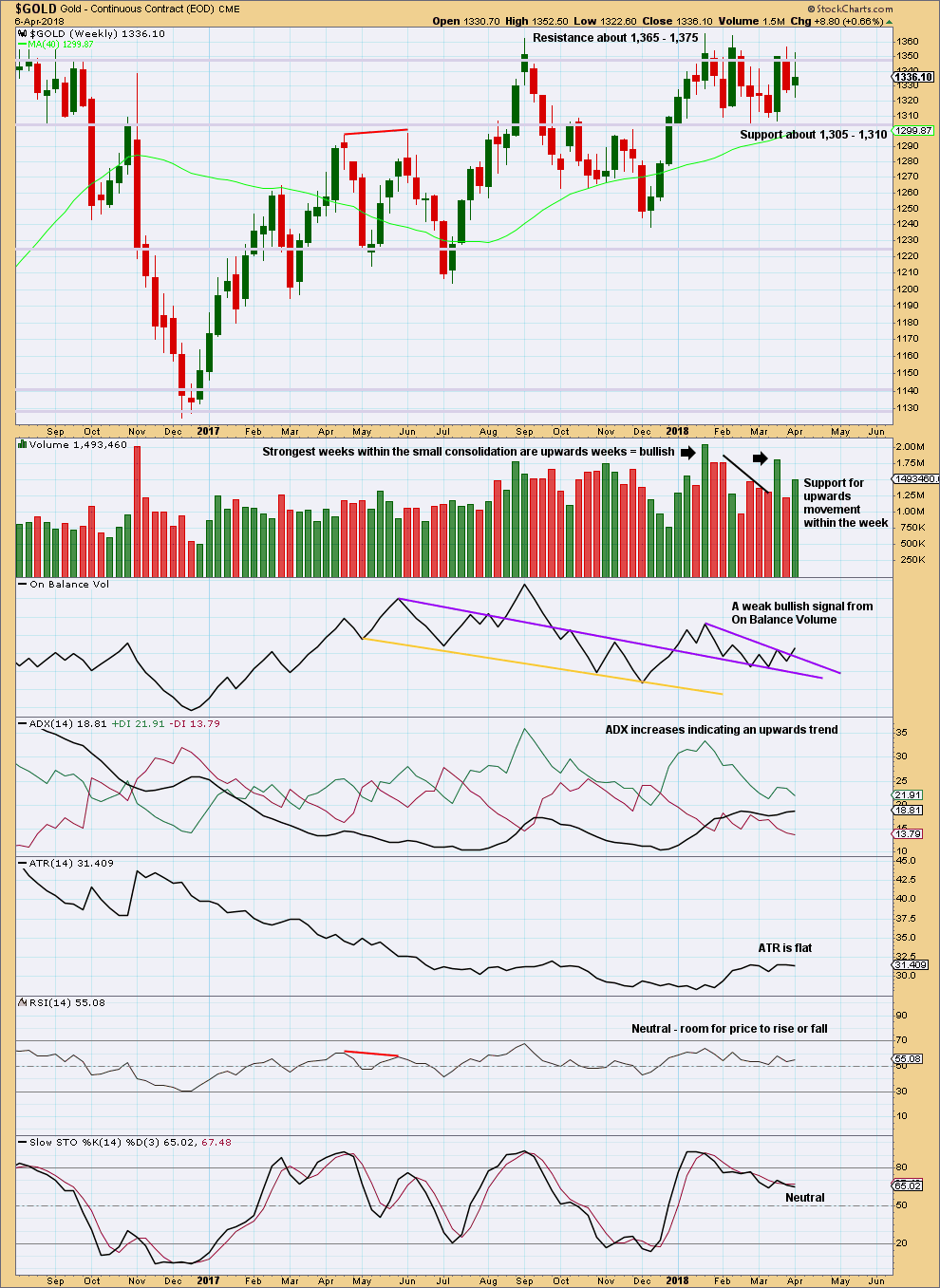
Click chart to enlarge. Chart courtesy of StockCharts.com.
Gold is within a small consolidation with resistance about 1,365 to (final) 1,375 and strong support about 1,310 to 1,305. Volume suggests an upwards breakout is more likely than downwards.
The bullish signal this week from On Balance Volume is weak because the purple line, which has been breached, has a reasonable slope and was only tested twice prior.
DAILY CHART
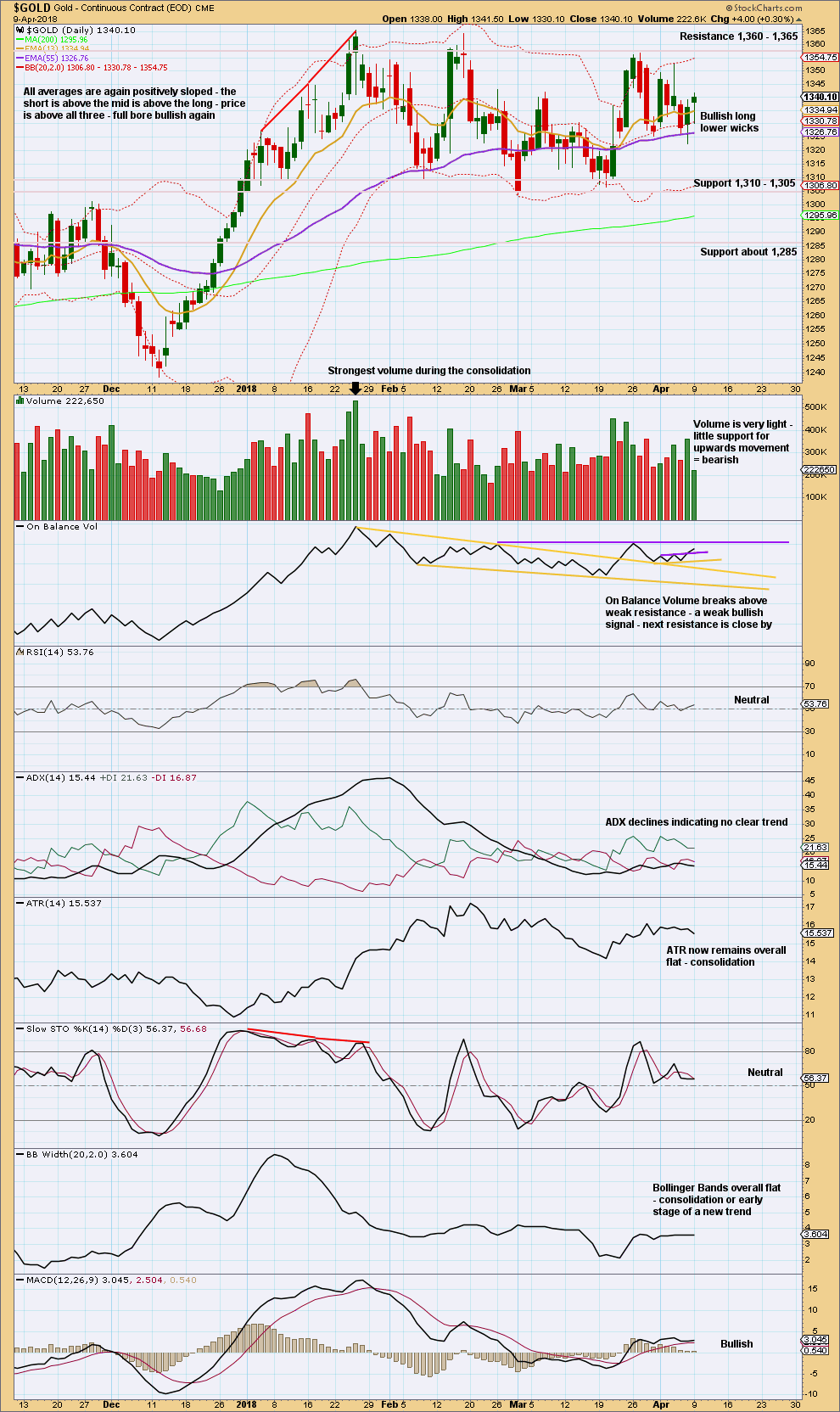
Click chart to enlarge. Chart courtesy of StockCharts.com.
Gold is within a smaller consolidation that began back on about the 3rd of January. This consolidation is delineated by resistance about 1,360 to 1,365 and support about 1,310 to 1,305. It is the upwards day of the 15th of January that has strongest volume during this consolidation. This suggests an upwards breakout may be more likely than downwards.
Although the last two daily candlesticks have long lower wicks (bullish), the steep decline in volume today is more bearish. Upwards movement during this session was very weak, so it may not continue.
If upwards movement does continue a little further, there is resistance ahead close by for On Balance Volume, which may halt the rise in price.
Overall, it still looks reasonable to expect a downwards swing to continue here to support. Do not expect it to move in a straight line.
GDX WEEKLY CHART
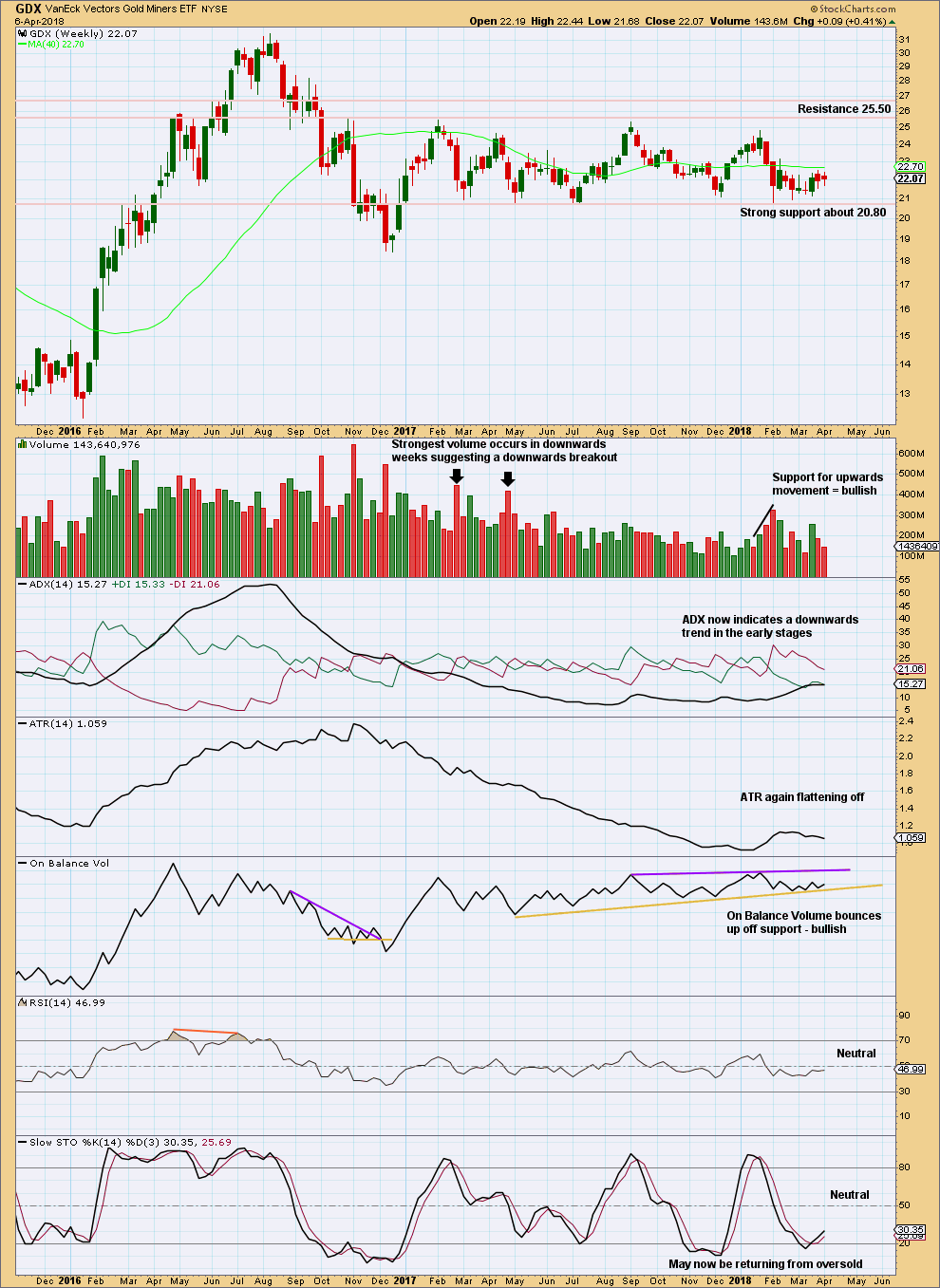
Click chart to enlarge. Chart courtesy of StockCharts.com.
Support about 20.80 has been tested about eight times and so far has held. The more often a support area is tested and holds, the more technical significance it has.
In the first instance, expect this area to continue to provide support. Only a strong downwards day, closing below support and preferably with some increase in volume, would constitute a downwards breakout from the consolidation that GDX has been in for a year now.
Resistance is about 25.50. Only a strong upwards day, closing above resistance and with support from volume, would constitute an upwards breakout.
The last week closes with the balance of volume upwards, and it shows a decline. This is contradicted by a bullish signal from On Balance Volume last week as it bounces up off support.
GDX DAILY CHART
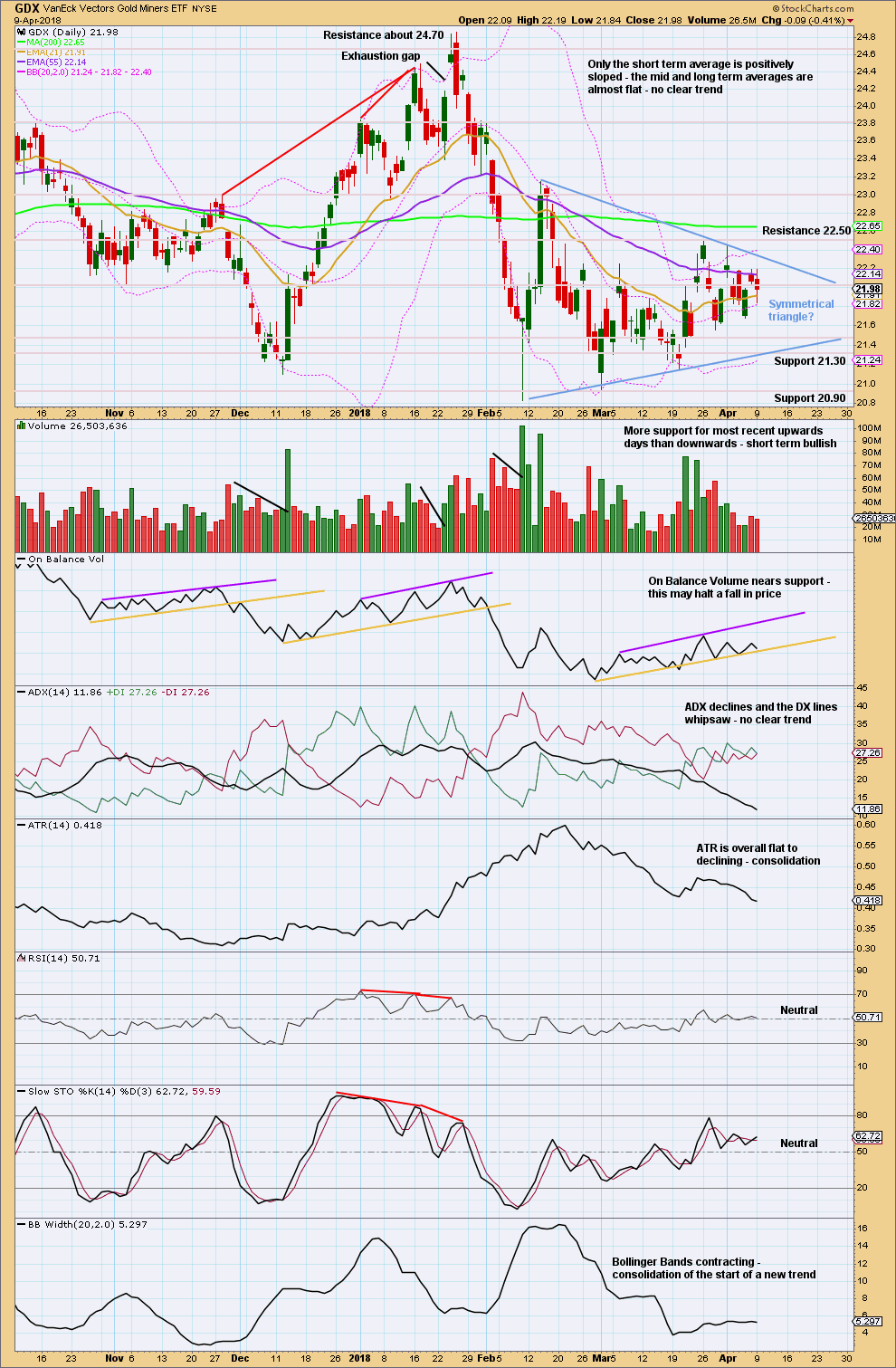
Click chart to enlarge. Chart courtesy of StockCharts.com.
GDX is range bound at both weekly and daily time frames. The smaller consolidation here has resistance now about 22.50 and support about 21.30 and 20.90.
On Balance Volume is also constrained.
A symmetrical triangle may be forming. A breakout would require a close above resistance or below support, preferably with support from volume. A target for the next trend may be calculated after a breakout.
The very short term volume profile remains bullish. A decline in volume today for downwards movement does not change this view.
Published @ 11:37 p.m. EST.

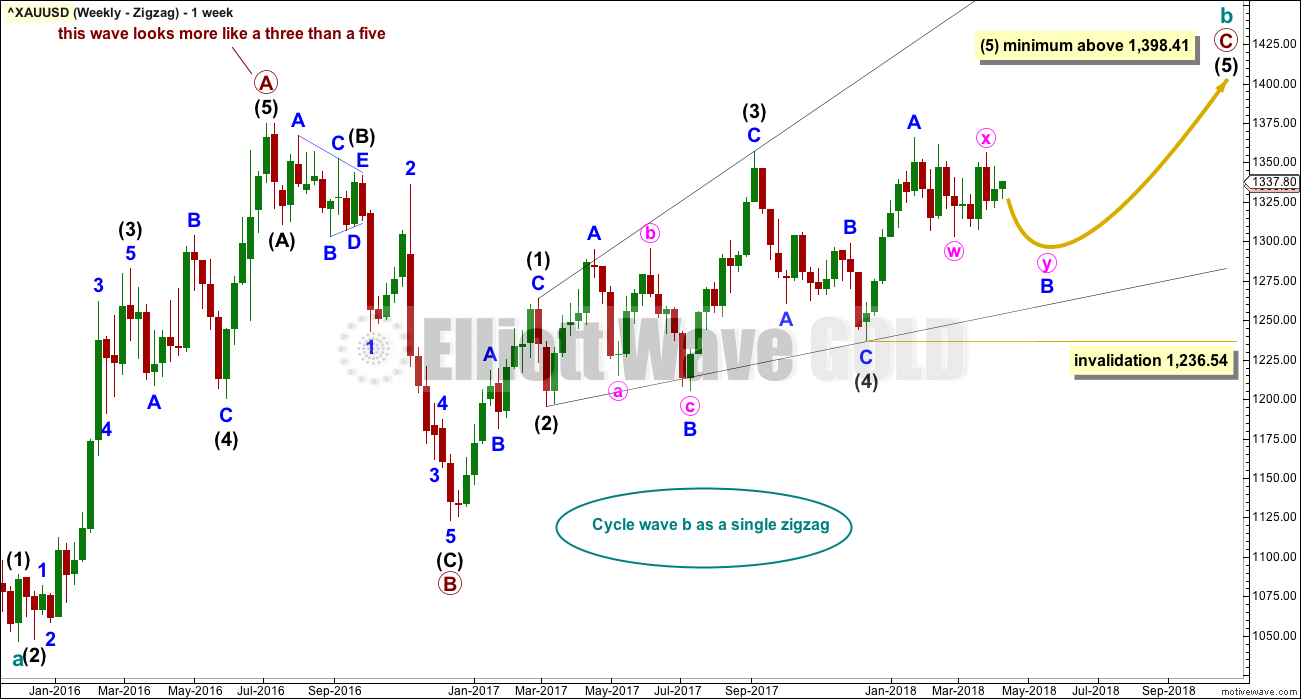
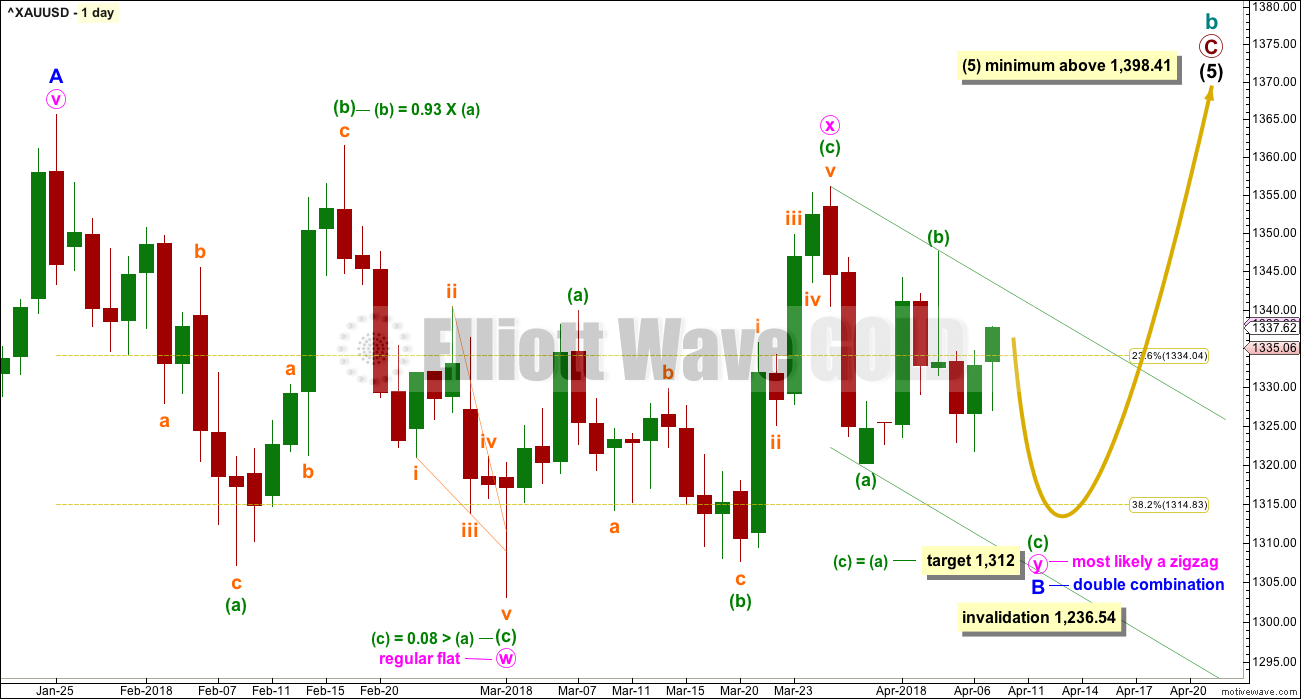
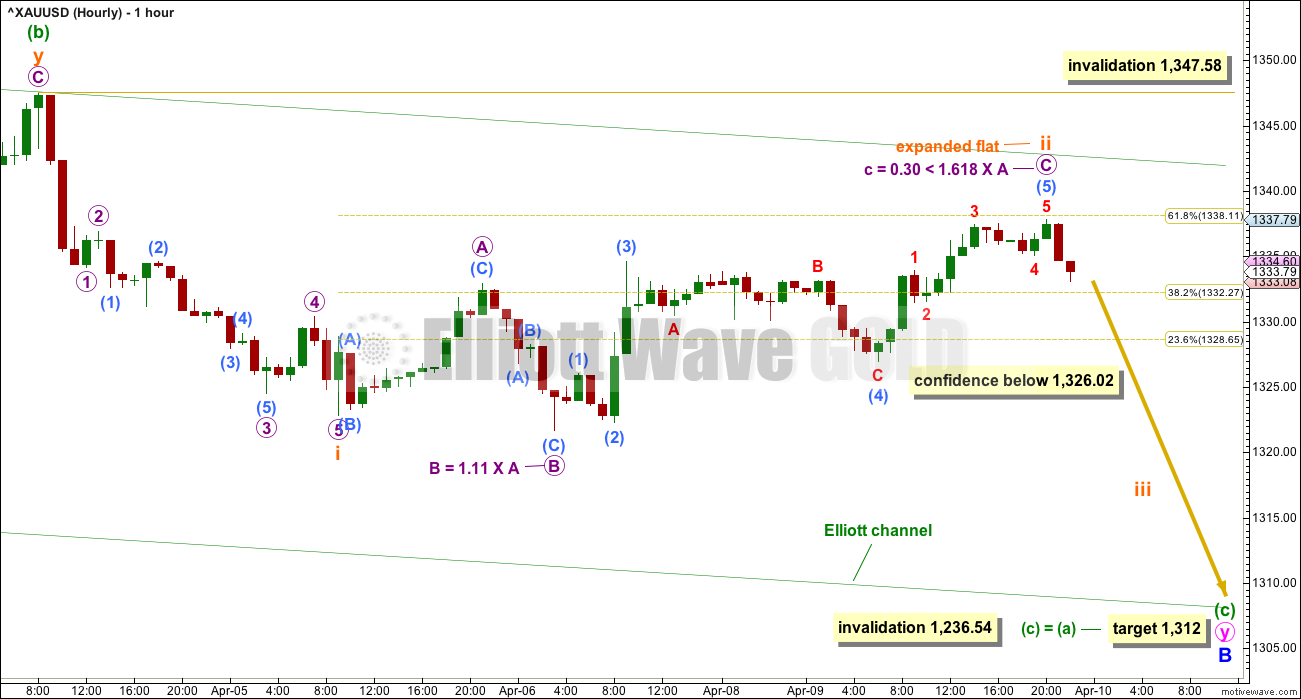
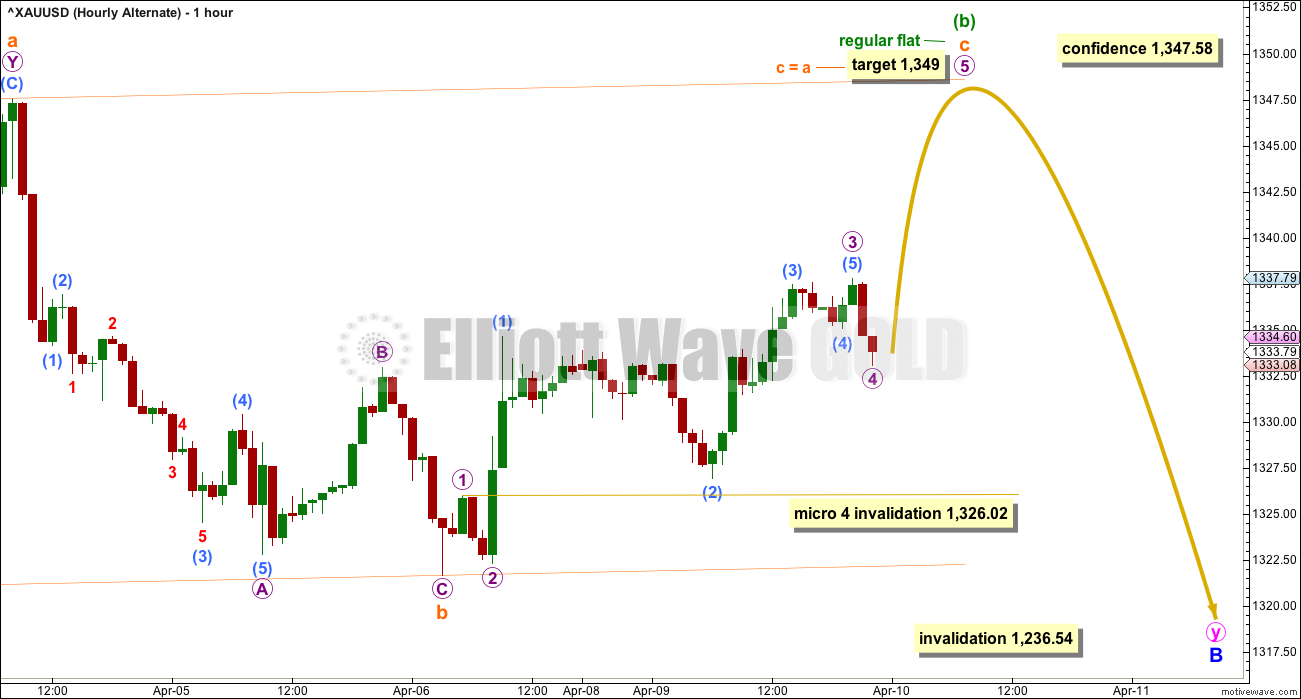
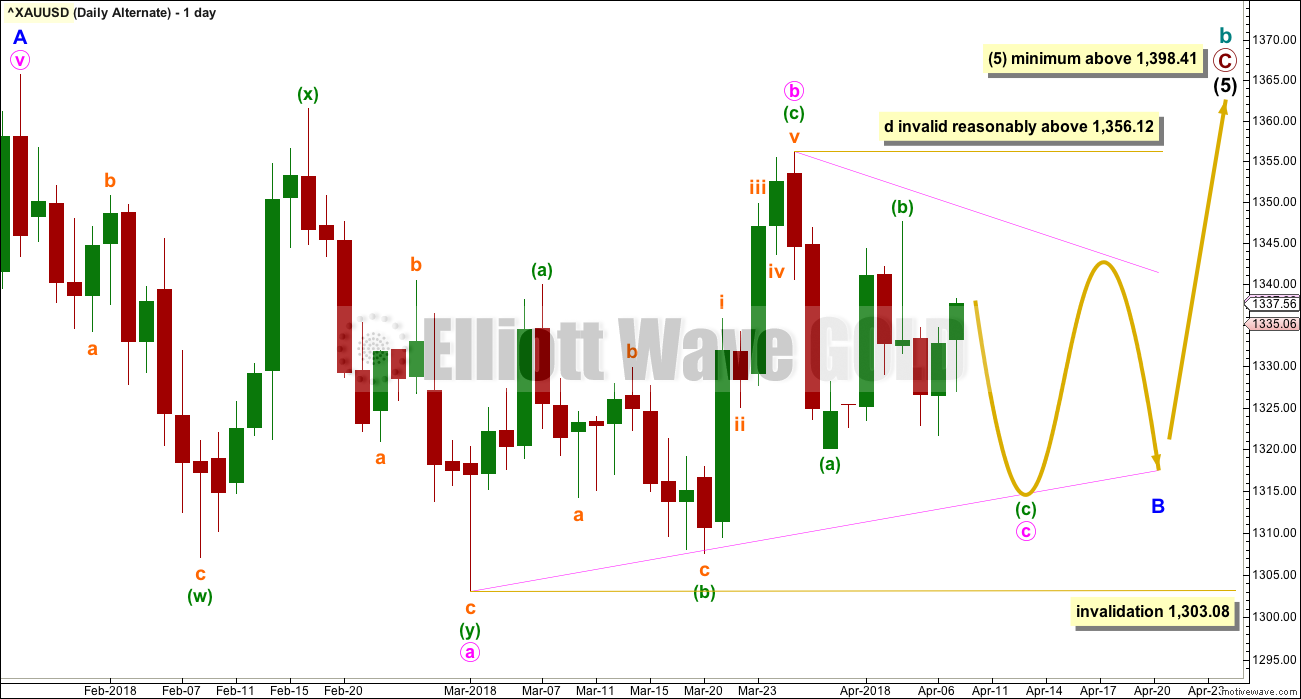
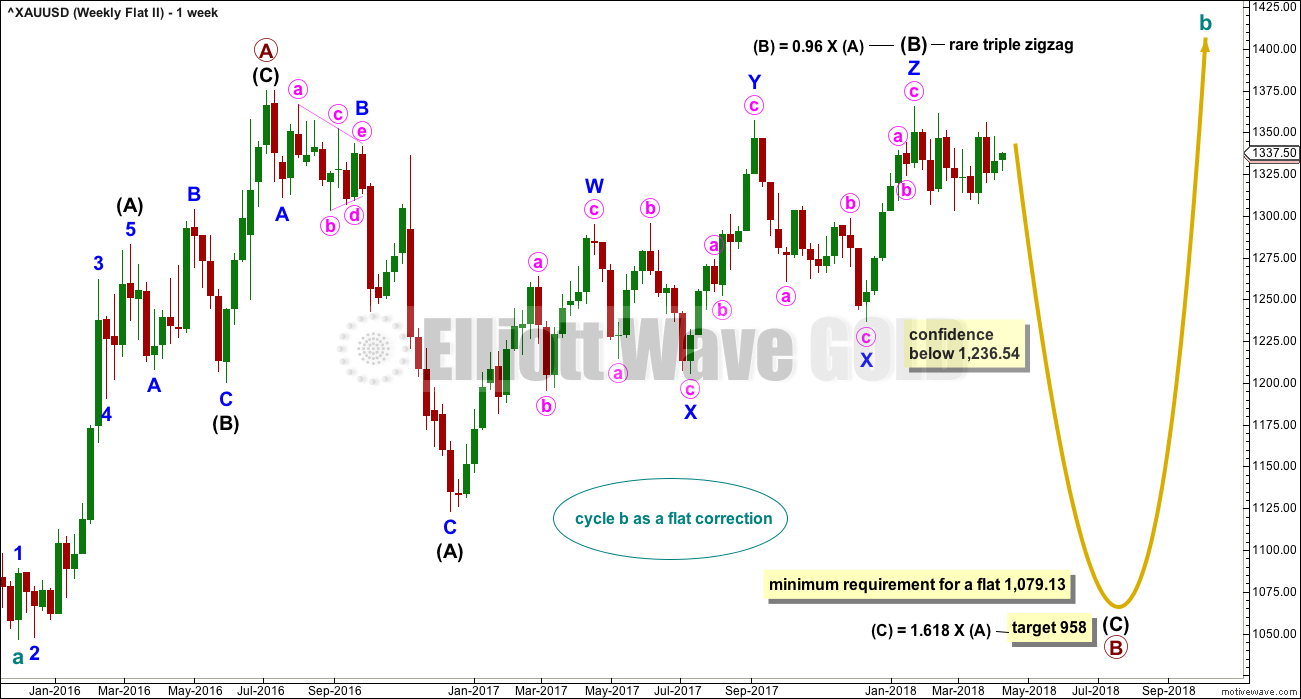
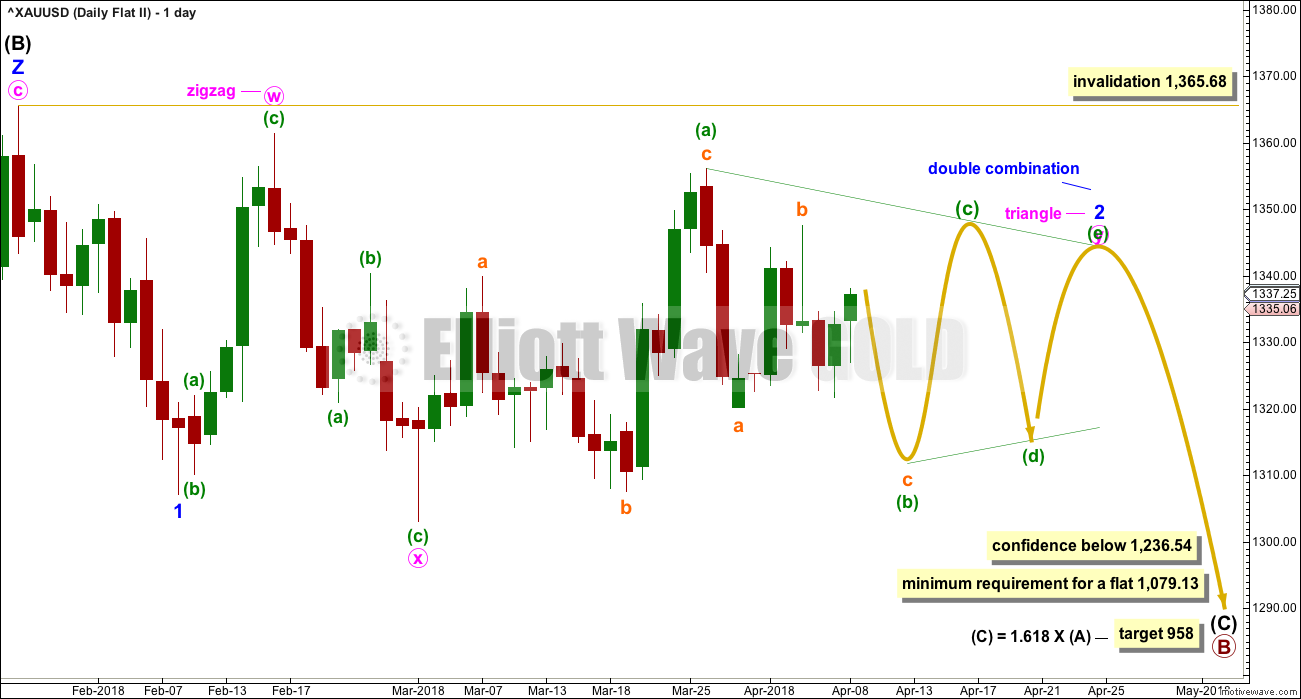
Updated main hourly count:
Notice price is now right at the upper edge of the channel. If this main count is correct it should turn here. That channel shouldn’t be breached.
Updated alternate hourly chart:
This may be the one. Minuette wave (b) may not be over.
Silver is breaking out of inv Hns pattern in hour period. GSR is also dropping means silver leads gold.
A start of major bull trend in PM Sector?
I don’t see a break of a neckline on Silver so far. I think it’s too early to say it’s breaking out, and it’s still within it’s consolidation zone.